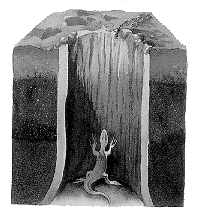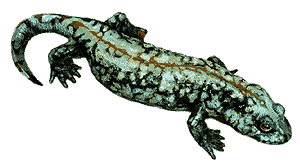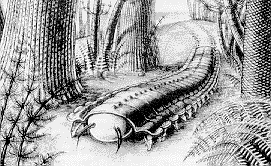    |
||||||
The Tree Stump Animals The first reptiles on Earth emerged 300 million
years ago and their remains have been found at Joggins, inside the trunks of lycopod
trees. Dawson and Lyell discovered Hylonomus lyelli, a tiny reptile, or
microsaur, as Dawson dubbed them, about 30 centimetres long. These tiny reptiles would,
over the next 100 million years, evolve into dinosaurs. The first reptiles on Earth emerged 300 million
years ago and their remains have been found at Joggins, inside the trunks of lycopod
trees. Dawson and Lyell discovered Hylonomus lyelli, a tiny reptile, or
microsaur, as Dawson dubbed them, about 30 centimetres long. These tiny reptiles would,
over the next 100 million years, evolve into dinosaurs. One widely held theory, first proposed by Dawson, was that animals such as Hylonomus lyelli became trapped in hollow tree stumps which had been snapped off and the exterior surrounded with sediment until the openings were at ground level. The unsuspecting animal would have then fallen into the hollowed tree trunk. Once trapped, Hylonomus lyelli and others either drowned immediately, starved to death or survived for a time scavenging on previous victims, only to be eaten by the next. Up to seventeen skeletons have been found inside one trunk! A more recent theory suggests that the animals lived and made their dens inside the hollow stumps.
Other creatures that have been found in the stumps include the world's oldest land snails (Pupa sp. and Zonites sp.) and a small, articulated worm-like creature called a gally worm.
|
 Also found by Dawson and Lyell in the tree stumps were the
remains of a primitive amphibian, Dendrerpeton acadianum. This animal reached
lengths of one metre and probably looked very much like a large salamander.
Also found by Dawson and Lyell in the tree stumps were the
remains of a primitive amphibian, Dendrerpeton acadianum. This animal reached
lengths of one metre and probably looked very much like a large salamander.  The largest creature at Joggins was an
arthropod (an invertebrate with a hard jointed exoskeleton) called Arthropleura sp.
At nearly two metres long, these animals resembled an extremely large sow bug. Arthropleura
may have had as many as 30 pairs of legs, and their tracks, resembling Caterpillar tractor
tracks, have also been found at Joggins. They were never trapped in the hollow tree stumps
because either they never lost their balance and fell into them or they were large enough
to scuttle their way right over the gaping holes.
The largest creature at Joggins was an
arthropod (an invertebrate with a hard jointed exoskeleton) called Arthropleura sp.
At nearly two metres long, these animals resembled an extremely large sow bug. Arthropleura
may have had as many as 30 pairs of legs, and their tracks, resembling Caterpillar tractor
tracks, have also been found at Joggins. They were never trapped in the hollow tree stumps
because either they never lost their balance and fell into them or they were large enough
to scuttle their way right over the gaping holes.